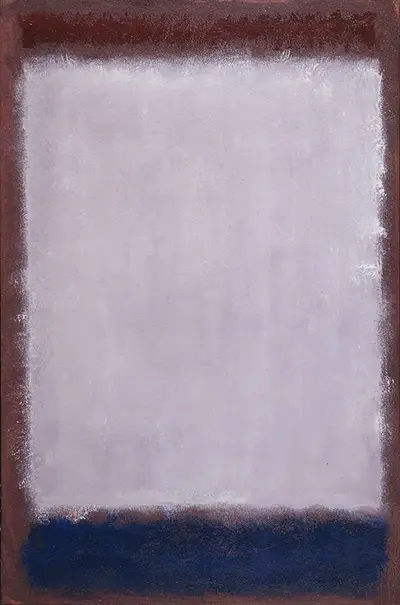This Rothko painting features three distinct Color Fields, as one might call them. There is a small, narrow band of blue across the bottom of the canvas, just above the background brown. There is also a subtle brown across the top which merges fairly closely with other parts of the painting and so is hard to spot. Across the centre of the artwork is a large expanse of white paint that pulls in tones from below which gives it the typical Rothko look of variation, with blurred edges to his lozenges. Around the sides of each of these bands of colour is a small space, allowing each one to exist independently. The background therefore appears between each of these colours and around the edges of the painting. Rothko would construct these colours on huge canvases so that when viewers arrive in the gallery they would be engulfed in colour, enabling them to enter a new world and immerse themselves into the emotions are laid out by the artist. Size was therefore a key attribute, though not something that can be understood by viewing a photograph of paintings such as Lavender and Mulberry.
Joseph H. Hirshhorn is believed to have gifted this painting to its current owners as far back as 1966. The painting is listed as having been completed on Oil on paper mounted on fiberboard and is listed by the institutions as being sized at 95.9 cm in height by 62.8 cm in width. As you would have guessed from the donor's name, this individual set up the gallery and sculpture garden using items from his own personal collection and since then the venue has continued to expand its collection, with a particular focus on contemporary art. Rothko remains one of the most important American artists from the 20th century, and so his inclusion here is critical. He also is particularly popular with even the most fleeting of art followers and so names such as his can really help to draw in more visitors, which remains the lifeblood of any art gallery. Washington D.C. continues to offer a good wealth of American art through a number of institutions, and this particular venue is one of the most important with regards contemporary art.
The Burghers of Calais by Auguste Rodin (1889) is one of the most exciting sculptures to be found in the outdoor part of the venue, and it one of its biggest attractions. You will also find indoors paintings from the likes of Pablo Picasso, Henri Matisse, Mary Cassatt and Jackson Pollock, with a truly impressive list of names featured here. With contemporary art continuing to grow quickly in terms of media coverage and interest from the public, it is galleries such as this that will probably do even better in future years, particularly as they start to embrace changes in society happening at the moment. Rothko alone is enough to draw people in, and American art is generally well represented right across this region for those with the time to visit some of its many different cultural offerings.


